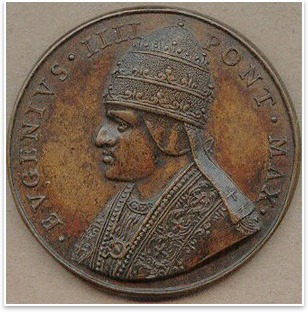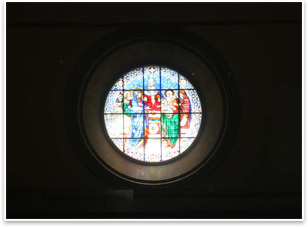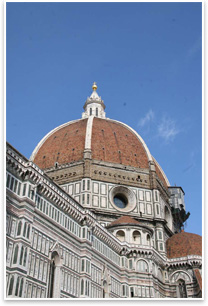ADVENTURES IN ARCHITECTURE: THE SERIES
Il Duomo: Brunelleschi and the Dome of Santa Maria del Fiore
Episode 9: Finito
by Jim Atkins, FAIA, FKIA
Illustrations by Jim Anderson
Summary: In our last episode, we explored the other side of the great Brunelleschi. Although he is celebrated for his many successful inventions and designs, he experienced numerous failures. His attempt to ship Carrera marble from Pisa down the Arno river to Florence failed when his uniquely designed amphibious boat capsized, sending his expensive cargo to the bottom of the river. He failed again during a military maneuver when he attempted to change the course of the Serchio River to surround and capture the enemy at Lucca. His plan backfired, resulting in the flooding of his own encampment.
Filippo operated with precision in the discharge of his duties. His temperament was sometimes volatile, and he was feared by many associates. But he was not always the serious businessman as many would tend to believe, he had a lighter side, and he was prone to play tricks on those around him. These often elaborate schemes were craftily constructed, and his genius often showed through these humorous and lighter actions. Filippo put his life into his work, and for more than 16 years tended to each and every minute detail required to construct the dome. He designed the machines to do the work, and he personally inspected each of the four million custom-made bricks that make up the dome structure.
His efforts were finally rewarded in 1436 when the great dome reached completion. His dream and his most significant architectural work had finally been realized. He had achieved what many said could not be done. He had designed and constructed the greatest masonry dome in existence. Return with us now to the 15th century as we experience Filippo’s ultimate triumph: substantial completion of the great dome of Santa Maria del Fiore. This was a big time accomplishment; and all of Rome, Tuscany, and the Pope himself would celebrate this great achievement. For our man, this would be the mother of all ribbon cuttings.
Episode 9: Finito
Perhaps it was the complexity of Brunelleschi’s personality that enabled him to persevere and spend more than 16 years constructing Il Duomo, or maybe he was just one tough dude. He overcame many challenges and solved many problems, and he ultimately completed the largest masonry span in history. The dome was constructed with an oculus at the top, which eventually was covered by a stone lantern structure. The stones around the oculus were the last components of the dome to be erected.
After the last course of stones was placed, with one stone left out for placement during the consecration, the dome was declared “finito,” or finished. Filippo’s dream and his lifetime endeavor had been realized; and it had been completed without centering. This adventurous goldsmith, who was compelled to become a student of Roman architecture and had earned his way to become a capomaestro, had finally proven himself to be one of the greatest architects, if not the greatest architect, of the Renaissance.
Many of us have worked on projects that we thought would never end. For this project, the challenges, the difficulty, the struggle seemed to go on forever. Can you imagine a project delivery lasting 16 years and two weeks? Thus was the duration of the construction of Il Duomo.
Demobilization
The cathedral interior at the time of consecration was quite different from the time during construction. In preparation for the grand celebration, the hoist was removed from the center of the octagon beneath the dome, where the oxen had trodden day after day for 16 years. The area was now cleared and paved with brick. The wall separating the work area of the octagon from the nave where worship had been conducted was removed. The octagon with its magnificent dome towering above was now a part of the cathedral itself.
 A temporary wooden choir loft was erected in preparation for the ceremony. The window openings in the drum were fitted with curtains to control the wind, and lamps for lighting were installed. The twelve statues of the apostles were given a fresh coat of paint. With the interior space now finished, the cathedral could be consecrated. A temporary wooden choir loft was erected in preparation for the ceremony. The window openings in the drum were fitted with curtains to control the wind, and lamps for lighting were installed. The twelve statues of the apostles were given a fresh coat of paint. With the interior space now finished, the cathedral could be consecrated.
Consecration of the cathedral
On March 25, 1436, the annual Feast of the Annunciation was an occasion beyond its usual celebration. Pope Eugenio IV entered the city with Cardinal Giuliano degli Orsini, the officiators of the ceremony. They were accompanied by an entourage of 6 other cardinals, 37 bishops, and 9 representatives of the Florentine government. This was a big time roll-out. Santa Maria del Fiore is interpreted as Saint Mary of the Flower, and its name is derived from a flower made of gold that Pope Eugenio IV gave the city shortly before the time of consecration.
For the occasion, our man Filippo had designed a walkway 1,000 feet long and 6 feet above the ground to allow the dignitaries to pass through the crowd without interruption. The budget apparently did not include bodyguards or event staff. More than 200,000 people crowded into the piazza from Florence, the countryside, and neighboring cities. It was a grand event for all of Tuscany.
The Pope, wearing his pluvial and accompanied by his entourage, negotiated the long walkway and entered the Piazza San Giovanni with great fanfare. The massive crowd cheered wildly, and celebration filled the air. After 140 years of continuous construction, the consecration of the cathedral of Santa Maria del Fiore was about to begin.
 The ceremony The ceremony
The cost of this great occasion was appropriated by the Opera del Duomo with 72 lire, 12 soldi, and 6 denari, certainly enough money in that time to throw a whiz-bang celebration. The attendees were dressed in red or green, and the chorus began with a resounding motet by Guillamume Dufay. The crowd quieted with humble reverence.
Pope Eugenio began the ceremony by placing relics on the altar: the finger bone of St. John the Baptist and the skull of St. Zenobius. Cardinal Giuliano degli Orsini began christening the altar, a significant event that would cause the spirits of the saints to inhabit the cathedral, thus allowing further miracles even beyond that of the construction of the magnificent dome itself.
The Cardinal of San Marco led the mass. All were properly dressed and wearing the white miter. It was a day that the Florentines would always remember. They had spent their lives in the shadow of the incomplete basilica. Now, at last, the symbol of their culture would be fulfilled.
The consecration of the cathedral was a significant occasion for Filippo. He had provided the grand architectural solution that had allowed the church to be completed. He had bridged the great span of the drum that had baffled the engineers of the time, and he had accomplished it without centering in difference to the great engineering minds of the day. All that remained now for Filippo was the consecration of Il Duomo.
Il Duomo finito
On August 30, 1436, about five months after Pope Eugenio had consecrated the cathedral, the dome was consecrated. It was the culmination of magnificent planning and enduring hard work, 16 years and 2 weeks after work had begun at Filippo’s direction. Florence could now boast of the greatest masonry span in all of Italy; greater than anything in Rome, and likely unbeknownst to the Florentines at the time, greater than any other dome in the world.
The man in charge of the event was the bishop of Fiesole. The Florentines celebrated as he climbed the steps to the top of the dome to lay the final stone in the radius of the oculus. Church bells rang, trumpets played, and the place rocked. It was a time of merriment and thanksgiving.
It is that time when we architects exhale slowly, and give thanks that our project has finally reached completion.
After the consecration was completed, a grand feast was held in the piazza. The dignitaries came down from the dome and dined upon the usual Florentine fare; meat, bread, fruit, cheese, pasta, and wine. It was a time of great celebration and rejoicing. You can follow the same route today, and climb to the top of Il Duomo, as we will do in the final episode of this series.
It was the ultimate achievement for Brunelleschi; this little genius who had created so much artistry in his lifetime. It is as if he were preparing himself for this great feat throughout his life. His goldsmith skills, his clock making, his years as a student of Roman construction—collectively groomed him to accomplish this great task. How many of us have had similar experiences on our career paths to become an architect? It is the preparatory, and sometimes menial, jobs we take and skills we develop along the way that can lend greatly to our ultimate accomplishments.
From slamming an egg on a table in order to make a point, to humbly standing to be recognized by the pope at the consecration, Filippo had accomplished much over those 16 years, and he had gained vast recognition along the way. He was now admired and respected as the true architect of the dome. From this day forward it would be Brunelleschi’s dome.
 Can you do windows? Can you do windows?
The sweet taste of triumph finally came to Filippo when Ghiberti was fired as capomaestro only two months before the consecration in 1436. After his unsuccessful attempt to construct the wooden chain, Lorenzo’s credibility had gone down the tubes, and he was never able to overcome it, even with his backroom scheming to have Brunelleschi arrested.
In the remaining years of dome construction after the wooden chain debacle, Ghiberti busied himself with other projects, including the completion of the baptistery doors of San Giovanni. His payment for services on the dome had been greatly reduced, while Filippo’s was increased to 100 Florins per year.
Lorenzo was relegated to designing the windows for the dome, a subordinated task to the great edifice that his rival, Filippo, had constructed. Although his stained glass designs were ultimately used and are quite remarkable, the great glory of being the architect of Il Duomo had nonetheless escaped him.
 Conclusion Conclusion
The path had been long and hard; the challenges great. This talented architect, who excelled in marketing skills, had talked his way into the project of a lifetime with an egg as his scepter. His greatness lay in his ability to back up his shtick with incredible inventive talent. He had traversed the boundaries of contemporary knowledge with his ability to solve the most unique problems at hand, including the creation of incredible machines to accomplish the demanding construction requirements.
He invested the whole of his professional life, from inspecting each and every unique brick required to construct the elaborate dome to managing the workforce that provided the labor. Il Duomo was his child, and he never neglected or failed to adore it, not for a moment in all of those years.
Now, in the end, the dome would belong to Brunelleschi, and only to him. No more splitting the pie, no more sharing the limelight; at last Filippo di ser Brunellesco di Lippo Lapi would forever stand alone as the capomaestro that conceived and built Il Duomo, the magnificent dome of the Basilica de Santa Maria del Fiore.
|



 The ceremony
The ceremony Can you do windows?
Can you do windows? Conclusion
Conclusion